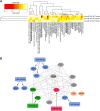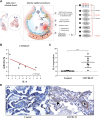Deregulated miRNA expression is associated with endothelial dysfunction in post-mortem lung biopsies of COVID-19 patients
- PMID: 33651636
- PMCID: PMC7938642
- DOI: 10.1152/ajplung.00457.2020
Deregulated miRNA expression is associated with endothelial dysfunction in post-mortem lung biopsies of COVID-19 patients
Abstract
MicroRNAs (miRNAs) are critical modulators of endothelial homeostasis, which highlights their involvement in vascular diseases, including those caused by virus infections. Our main objective was to identify miRNAs involved in the endothelial function and determine their expression in post-mortem lung biopsies of COVID-19 patients with severe respiratory injuries and thrombotic events. Based on functional enrichment analysis, miR-26a-5p, miR-29b-3p, and miR-34a-5p were identified as regulators of mRNA targets involved in endothelial and inflammatory signaling pathways, as well as viral diseases. A miRNA/mRNA network, constructed based on protein-protein interactions of the miRNA targets and the inflammatory biomarkers characterized in the patients, revealed a close interconnection of these miRNAs in association to the endothelial activation/dysfunction. Reduced expression levels of selected miRNAs were observed in the lung biopsies of COVID-19 patients (n = 9) compared to the Controls (n = 10) (P < 0.01-0.0001). MiR-26a-5p and miR-29b-3p presented the best power to discriminate these groups (area under the curve (AUC) = 0.8286, and AUC = 0.8125, respectively). The correlation analysis of the miRNAs with inflammatory biomarkers in the COVID-19 patients was significant for miR-26a-5p [IL-6 (r2 = 0.5414), and ICAM-1 (r2 = 0.5624)], and miR-29b-3p [IL-4 (r2 = 0.8332) and IL-8 (r2 = 0.2654)]. Altogether, these findings demonstrate the relevance and the non-random involvement of miR-26a-5p, miR-29b-3p, and miR-34a-5p in endothelial dysfunction and inflammatory response in patients with SARS-CoV-2 infection and the occurrence of severe lung injury and immunothrombosis.
Keywords: COVID-19; SARS-CoV-2; endothelial dysfunction; lung injuries; microRNA.
Figures



Similar articles
-
SIV Infection Regulates Compartmentalization of Circulating Blood Plasma miRNAs within Extracellular Vesicles (EVs) and Extracellular Condensates (ECs) and Decreases EV-Associated miRNA-128.Viruses. 2023 Feb 24;15(3):622. doi: 10.3390/v15030622. Viruses. 2023. PMID: 36992331 Free PMC article.
-
Differential microRNA expression in the peripheral blood from human patients with COVID-19.J Clin Lab Anal. 2020 Oct;34(10):e23590. doi: 10.1002/jcla.23590. Epub 2020 Sep 22. J Clin Lab Anal. 2020. PMID: 32960473 Free PMC article.
-
Bronchial Aspirate-Based Profiling Identifies MicroRNA Signatures Associated With COVID-19 and Fatal Disease in Critically Ill Patients.Front Med (Lausanne). 2022 Feb 3;8:756517. doi: 10.3389/fmed.2021.756517. eCollection 2021. Front Med (Lausanne). 2022. PMID: 35186962 Free PMC article.
-
Investigation of miR-26a-5p and miR-19a-3p expression levels in angiographically confirmed coronary artery disease.Acta Cardiol. 2023 Oct;78(8):945-956. doi: 10.1080/00015385.2023.2227484. Epub 2023 Jun 28. Acta Cardiol. 2023. PMID: 37376990
-
Genetic and Epigenetic Intersections in COVID-19-Associated Cardiovascular Disease: Emerging Insights and Future Directions.Biomedicines. 2025 Feb 16;13(2):485. doi: 10.3390/biomedicines13020485. Biomedicines. 2025. PMID: 40002898 Free PMC article. Review.
Cited by
-
Thymoquinone: A Promising Natural Compound with Potential Benefits for COVID-19 Prevention and Cure.Drug Des Devel Ther. 2021 May 3;15:1819-1833. doi: 10.2147/DDDT.S308863. eCollection 2021. Drug Des Devel Ther. 2021. PMID: 33976534 Free PMC article. Review.
-
Gene Network Analysis of the Transcriptome Impact of SARS-CoV-2 Interacting MicroRNAs in COVID-19 Disease.Int J Mol Sci. 2022 Aug 17;23(16):9239. doi: 10.3390/ijms23169239. Int J Mol Sci. 2022. PMID: 36012503 Free PMC article. Review.
-
MiRNA-SARS-CoV-2 dialogue and prospective anti-COVID-19 therapies.Life Sci. 2022 Sep 15;305:120761. doi: 10.1016/j.lfs.2022.120761. Epub 2022 Jul 1. Life Sci. 2022. PMID: 35787998 Free PMC article. Review.
-
Problems of Pathogenesis and Pathogenetic Therapy of COVID-19 from the Perspective of the General Theory of Pathological Systems (General Pathological Processes).Int J Mol Sci. 2021 Jul 15;22(14):7582. doi: 10.3390/ijms22147582. Int J Mol Sci. 2021. PMID: 34299201 Free PMC article. Review.
-
Non-coding RNAs expression in SARS-CoV-2 infection: pathogenesis, clinical significance, and therapeutic targets.Signal Transduct Target Ther. 2023 Dec 6;8(1):441. doi: 10.1038/s41392-023-01669-0. Signal Transduct Target Ther. 2023. PMID: 38057315 Free PMC article. Review.
References
-
- Ackermann M, Verleden SE, Kuehnel M, Haverich A, Welte T, Laenger F, Vanstapel A, Werlein C, Stark H, Tzankov A, Li WW, Li VW, Mentzer SJ, Jonigk D. Pulmonary vascular endothelialitis, thrombosis, and angiogenesis in Covid-19. N Engl J Med 383: 120–128, 2020. doi:10.1056/NEJMoa2015432. - DOI - PMC - PubMed
-
- Xu Z, Shi L, Wang Y, Zhang J, Huang L, Zhang C, Liu S, Zhao P, Liu H, Zhu L, Tai Y, Bai C, Gao T, Song J, Xia P, Dong J, Zhao J, Wang FS. Pathological findings of COVID-19 associated with acute respiratory distress syndrome. Lancet Respir Med 8: 420–422, 2020. [Erratum inLancetRespir Med. 8: e26; 2020]. doi:10.1016/S2213-2600(20)30076-X. - DOI - PMC - PubMed
-
- Hoffmann M, Kleine-Weber H, Schroeder S, Krüger N, Herrler T, Erichsen S, Schiergens TS, Herrler G, Wu NH, Nitsche A, Müller MA, Drosten C, Pöhlmann S. SARS-CoV-2 cell entry depends on ACE2 and TMPRSS2 and is blocked by a clinically proven protease inhibitor. Cell 181: 271–280, 2020. doi:10.1016/j.cell.2020.02.052. - DOI - PMC - PubMed
LinkOut - more resources
Full Text Sources
Other Literature Sources
Miscellaneous

